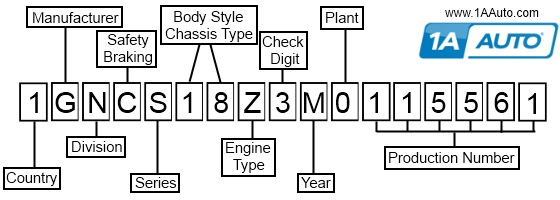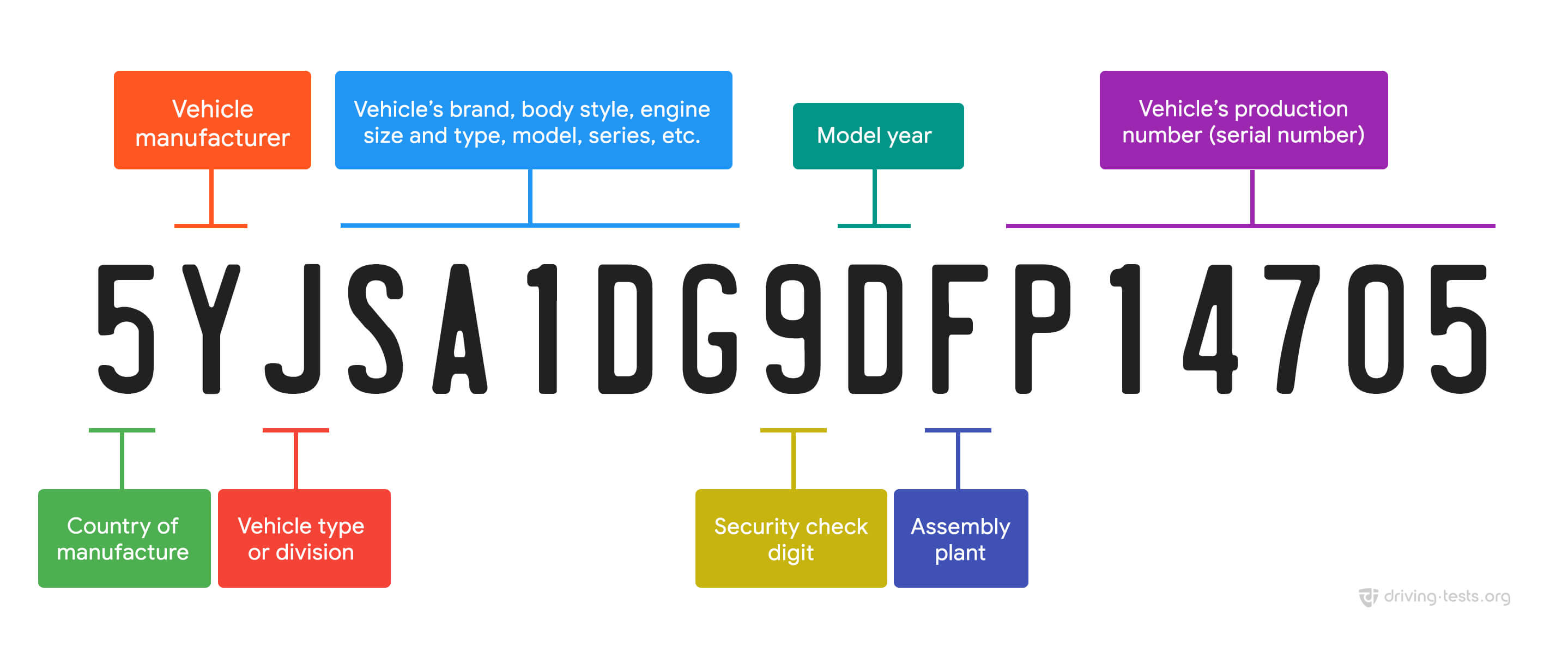The engine size of a vehicle can be determined by decoding the VIN (Vehicle Identification Number), specifically the eighth character, which represents the engine code. This code provides information about the engine’s type and size.
When purchasing a car, whether it’s new or used, one of the most important details is its engine size. The engine size directly influences the vehicle’s performance, fuel efficiency, and overall driving experience. While most car enthusiasts or buyers may know the make and model of a car, many are unaware that you can easily find out the engine size by simply looking at the car’s Vehicle Identification Number (VIN).
In this guide, we’ll explore how to determine a vehicle’s engine size using the VIN, why this information is important, and how you can decode it.

Credit: www.1aauto.com
Contents
What is a VIN Number?
A Vehicle Identification Number (VIN) is a unique 17-character alphanumeric code assigned to every motor vehicle manufactured since 1981. It serves as a unique fingerprint for the vehicle, providing key details like the manufacturer, model year, place of origin, and engine type. The VIN is used by automotive manufacturers, repair shops, insurance companies, and government agencies to track and identify vehicles.
The Structure of a VIN
A VIN consists of 17 characters, each of which corresponds to specific information about the vehicle. These characters are broken into three main sections:
- World Manufacturer Identifier (WMI) (Characters 1-3): Identifies the manufacturer and the country of origin.
- Vehicle Descriptor Section (VDS) (Characters 4-9): Describes the model, engine type, and body style.
- Vehicle Identifier Section (VIS) (Characters 10-17): Provides details like the vehicle’s model year, plant of manufacture, and the vehicle’s unique serial number.
Why is Engine Size Important?
The engine size of a vehicle refers to the total volume of all cylinders in the engine, usually measured in liters or cubic inches. It plays a crucial role in determining a vehicle’s power output, fuel efficiency, and overall performance. Knowing the engine size is important for:
- Choosing the Right Parts: Replacement parts such as oil filters, spark plugs, or air filters may differ based on engine size.
- Understanding Vehicle Performance: Larger engines typically offer more horsepower and torque, but they may be less fuel-efficient than smaller engines.
- Compliance with Regulations: Certain states or countries have emission standards based on engine size.
- Fuel Efficiency: Generally, smaller engines are more fuel-efficient, while larger engines provide more power for towing or performance.

Credit: www.mopar.com
How to Find and Decode Engine Size by VIN Number
Decoding the VIN to determine engine size involves understanding the structure of the VIN and knowing where to look for engine-specific information.
Step 1: Locate the VIN
The VIN can typically be found in several places on the vehicle:
- Dashboard: Look through the windshield at the driver’s side corner of the dashboard.
- Driver’s Side Door Frame: It is often printed on a sticker located on the driver’s side door jamb.
- Vehicle Documents: The VIN is also listed on the vehicle title, registration, insurance documents, and sometimes on service records.
Step 2: Identify the Engine Code in the VIN
The eighth character of the VIN represents the engine code, which provides information about the engine size, type, and sometimes its configuration. Each manufacturer assigns specific codes for their engines, so this character can vary significantly between different brands and models.
For example:
- A “K” in the eighth position of a Chevrolet VIN might represent a 5.3-liter V8 engine.
- A “C” in a Ford VIN could indicate a 2.0-liter four-cylinder engine.
Step 3: Use a VIN Decoder Tool
While you can manually decode the VIN by referencing manufacturer-specific tables, the easiest way to determine the engine size is by using an online VIN decoder tool. Many free VIN decoder websites or apps will allow you to enter a17-digit VIN and provide detailed information about the vehicle, including the engine size and type.
Popular VIN decoders include:
- NICB (National Insurance Crime Bureau) VINCheck: This tool is primarily used for checking if a vehicle has been reported as stolen, but it can also give some basic vehicle details.
- VINDecoder.net: This free tool provides comprehensive vehicle details, including engine specifications.
- Manufacturer Websites: Some automakers, like Ford or GM, have VIN decoder tools on their official websites.
- VIN Decoder Websites: A few trusted VIN decoder websites include:
Step 4: Consult the Owner’s Manual or Dealership
If you’re unsure about decoding the VIN yourself, or the online tools are not providing enough detail, you can always refer to the vehicle’s owner’s manual. This document typically includes all relevant specifications, including engine size. Alternatively, your local dealership can help you decode the VIN and provide the exact engine specifications for the vehicle.

Credit: driving-tests.org
Examples of Engine Codes by Manufacturer
Different manufacturers use different codes in the VIN to indicate engine size. Here are a few examples from popular car brands:
Chevrolet
- 8th Character: Engine Type
- “K”: 5.3L V8
- “8”: 6.0L V8
- “V”: 4.8L V8
Ford
- 8th Character: Engine Type
- “E”: 5.0L V8
- “C”: 2.0L I4
- “W”: 4.6L V8
Toyota
- 8th Character: Engine Type
- “F”: 4.0L V6
- “L”: 3.5L V6
- “R”: 1.8L I4
Honda
- 8th Character: Engine Type
- “C”: 2.4L I4
- “B”: 3.5L V6
These are just a few examples, and it’s important to remember that engine codes can vary depending on the model year and region of manufacture. Checking with the manufacturer or using a VIN decoder is the best way to confirm engine size.
Benefits of Knowing Engine Size
Identifying the engine size by VIN is important for several practical reasons:
1. Accurate Parts Replacement
When replacing engine parts or performing maintenance, it’s critical to have the correct engine size to ensure compatibility. Whether it’s a spark plug, air filter, or oil filter, knowing the engine size will help you purchase the correct part.
2. Performance Upgrades
If you’re looking to enhance the vehicle’s performance, understanding the engine size is the first step. Many performance modifications, such as upgrading the exhaust, intake, or even turbocharging, depend on knowing the engine’s specifications.
3. Resale Value
Prospective buyers are often interested in the engine size when evaluating a used vehicle. Larger engines typically indicate higher performance, while smaller engines might appeal to those seeking better fuel efficiency.
4. Towing Capacity
If you use your vehicle for towing, knowing your engine size is crucial. Larger engines provide more torque, which is necessary for towing heavy loads.
5. Insurance Premiums
Some insurance companies take engine size into account when calculating premiums. Larger engines, which typically offer more power, may result in higher insurance costs compared to vehicles with smaller, more fuel-efficient engines.
Frequently Asked Questions
Here are some FAQs about engine size by VIN number –
1. Can I find the engine size of any vehicle using the VIN?
Yes, you can find the engine size of most vehicles using the VIN. The eighth character in the VIN typically represents the engine code, which you can decode to identify the engine size.
2. Is there a difference between engine type and engine size in the VIN?
Yes, the engine type refers to the engine’s configuration (e.g., V8, I4, etc.), while engine size is the displacement of the engine, often measured in liters or cubic inches. Both details can often be derived from the VIN.
3. Can I use the VIN to check if my engine has been replaced?
If the engine has been replaced with an engine of a different size or type, the VIN will not reflect this change. The VIN only provides details about the vehicle’s original engine. You would need to physically check the engine for identification numbers to verify if it has been swapped.
4. What other information can I get from my VIN?
In addition to engine size, a VIN provides details like the manufacturer, model year, plant of manufacture, vehicle type, and the unique serial number. VINs are also used to track recalls, warranty claims, and theft records.
5. How reliable is VIN decoding for engine size?
VIN decoding is highly reliable when using the correct decoding tools or referencing manufacturer-specific information. However, if the engine has been modified or replaced, the VIN will not provide accurate details about the current engine.
Conclusion
Knowing engine sizes through VIN numbers is important for vehicle owners. It enables them to access valuable information about their vehicles quickly and accurately. By decoding the VIN, individuals can gain insights into their engine’s specifications and make informed decisions about maintenance and upgrades.
Embracing this knowledge empowers car enthusiasts and enhances their overall driving experience.